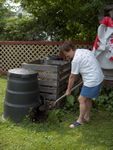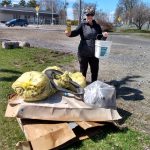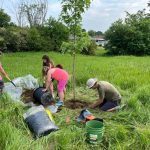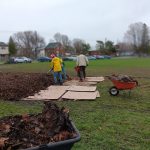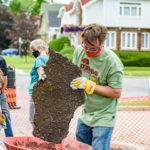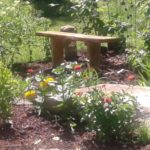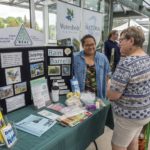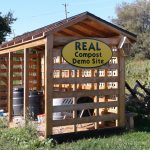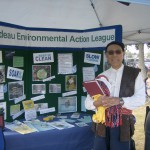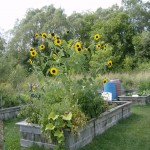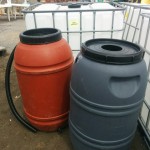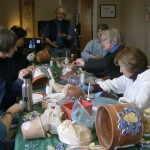STEP BY STEP HEALTHY LAWN CARE
- Aerate in late April
- Overseed after aerating
- Cut high – 3”
- Fertilize — with organic fertilizers — in early June
- Water 1” a week at most
- Fertilize in late August
- Overseed in September
- Fertilize in mid October
HEALTHY LAWN CARE – WHAT IS IT?
Synthetic fertilizers and pesticides mask what is truly going on in your lawn. Using proper cultural practices you can achieve the results you want without worrying about the negative effects of pesticide use on you, your family and your pets.
HOW GRASS GROWS
- It is a common myth that grass gets its food from fertilizer. Plants, including grass, get their food from sunlight.
- The grass leaves use sunlight and carbon dioxide to make sugars that the grass plant uses for food. The roots supply water and nutrients. Fertilizer provides these nutrients but is not in itself food.
- For good growth we need lots of green blades of grass to produce the food and lots of roots to supply water.
- The length of the blades and roots are proportional; that means the roots are generally as long as the blades.
- If you cut your grass too short, you are destroying the food producing area and causing shallow roots.
- When faced with a dry period, the combination of short blades (less food, no shade for the roots) and shallow roots (close to the surface) will cause your lawn to burn or go dormant and then the weeds move in.
CUT THE GRASS — 3” Please
It is very important not to cut your grass too low. In spring, 2.5” is a good height but 3” is better for the hot summer sun. In the fall go back to 2.5”, if you want, and give it a short cut just before you put your mower away for the season (2”). Do cut the grass over your septic system.
WATER — 1/week 6” deep
The surest way to ruin a lawn is to water it lightly several times a week. The water will evaporate quickly and cause the roots to reach for the surface to get to it. These shallow roots will burn in the hot sun of a dry spell.
Grass needs one inch of water per week and it needs that water at least six inches deep in the soil. Watering deeply encourages deep roots that won’t be as susceptible to heat and drought.
Don’t water the grass over the septic leaching bed – it doesn’t need it.
GRASS CLIPPINGS – Leave‘em where they lie
Generally, leave grass clippings on the lawn, as they are rich in nitrogen. Obviously if your lawn has become a hay field you will need to collect them.
Leave them for a day or two to dry out and then collect them for compost or to use as mulch. A mulching mower will help as well.
FERTILIZERS
There is no point in feeding your lawn a high nitrogen diet just so you can cut the grass twice a week. Nitrogen (N), the first number on your fertilizer bag, can cause excessive green growth. And though it may look like your lawn is very healthy this excessive growth is weak and prone to disease and insect attack.
Organic fertilizers don’t cause this problem, as there are no organic ingredients that are so high in nitrogen as to cause excessive growth and they are slow-release. Try to keep the nitrogen down around 15 % in June and as little as possible for your fall treatment.
Organic Fertilizers
- Recommended
- Contain trace elements and provide long-term benefits
- Do not kill off the worm population, as chemical fertilizers tend to do.
- Worm castings are excellent lawn fertilizers in themselves
Any fertilizer has three basic ingredients: Nitrogen (N), Phosphorous (P) and Potassium (K). N supports lush growth, P builds roots, and K increases hardiness. These are listed as a percentage of the whole content, for example, as 8-5-2. This example totals 15%, which means the rest of the bag is filler. Filler is often comprised of powdered rock, which can increase soil acidity. Organic fertilizers have trace elements essential to your lawn’s well being, as well as organic material, such as seaweed. This increases the biological activity in the soil and helps the soil to hold moisture and resist compaction. A slow-release organic fertilizer is essential to building a healthy lawn. Compost is ideal. It can be screened and spread as fertilizer. Put the large particles in the flower or vegetable garden.
LAWN PROBLEMS
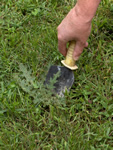 Weeds – They cause most of the headaches you will encounter with your lawn. Try to remember that no lawn can be free of weeds. Ultimately you will have to pull a few. However by overseeding in spring and fall, your lawn will be so thick that most weeds will be crowded out. Corn Gluten Meal applied at 10kg/1000sf will cause a significant decrease in germinating weeds according to the University of Iowa. Apply in late spring or early fall. www.hort.iastate.edu/gluten/home.html
Weeds – They cause most of the headaches you will encounter with your lawn. Try to remember that no lawn can be free of weeds. Ultimately you will have to pull a few. However by overseeding in spring and fall, your lawn will be so thick that most weeds will be crowded out. Corn Gluten Meal applied at 10kg/1000sf will cause a significant decrease in germinating weeds according to the University of Iowa. Apply in late spring or early fall. www.hort.iastate.edu/gluten/home.html
Insects – Most insect problems can be reduced with proper maintenance and just a little outside help. The most destructive pest in the lawn is the white grub, which eats the grass roots. Skunks and moles will dig up your lawn looking for these grubs. By reducing the grubs you get rid of these digging pests. A very effective form of control for grubs is a microscopic parasite called a nematode. Once watered into the soil to the level of the grubs, the nematodes invade the grub causing its death. To be effective it must be applied in late May/early June and/or early September.
Thatch – Most lawns have a thatch problem, caused by poor maintenance practices. A chemical program increases the problem because it boosts growth and slows the natural disintegration of the old roots and runners. This thatch layer harbours insects and slows the rate at which the lawn can absorb water. Chemicals also kill the worms that normally loosen the soil and allow air to reach the roots. To deal with both of these problems, aerate the lawn. Core aeration removes plugs of soil 2” – 3” deep allowing water, fertilizer and air to penetrate. It also speeds up the breakdown of thatch.
NATIVE PLANTS
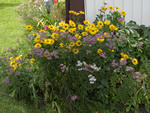 The Canadian Wildlife Federation maintains a list of native plant suppliers across Canada.
The Canadian Wildlife Federation maintains a list of native plant suppliers across Canada.
If you are coming by the REAL Deal, take a look at our native garden in front of the store!
NATIVE PLANT SUPPLIERS IN LANARK, LEEDS AND GRENVILLE COUNTIES
Updated April 2015
If you are, or know of, a native plant supplier in our area, please let us know.
Carleton Place Nursery
County Road 29
Carleton Place
613-257-8175
www.carletonplacenursery.com
Devra Rayvals
64 George St.
Brockville
613-345-4714
[email protected]
Ferguson Forest Centre and Ontario Woodlot Association
275 County Road 44
Kemptville 888-791-1103
www.seedlingnursery.com
Native trees and shrubs
Forget-me-not Herbs ‘n’ Wildflowers
1920 Beach Road
Oxford Mills
613-258-1246
[email protected]
Limited quantities of native plants
Garden Market Garden Centre
115 William Street West
Smiths Falls
613-283-4821
[email protected]
Gardens North
5984 Third Line Rd. N., North Gower
613-489-0065 or 613-489-1208
[email protected]
Gemmell’s Garden Centre
11862 Hwy 15 RR3
Smiths Falls
613-283-6371
www.gemmellsgardencentre.com
Green Things Garden Centre
1892 Hwy 2 East
Brockville
613-258-2839
www.greenthings.net
Native herbaceous and woody species
Hillside Gardens
313 Wayside Drive off Hwy 7, E of
Perth
613-267-4031
www.hillsidegardensperth.com
Kiwi Gardens
687 Harper Road RR7
Perth
613-267-7384
www.kiwigardens.ca
Native and drought-tolerant species
Old Field Garden & Wildflower Nursery
2935 Porter Road
Oxford Station
613-258-7945
[email protected]
Plant list and good links on Web site
Parks Perennials
McDonald’s Corners
613-278-2739
Saturday mornings May-October
at McDonald’s Corners Farmers Market
[email protected]
Woodland/grassland perennials
Pioneer Nursery
632 Van Buren Street
Kemptville
613-258-5555
www.pioneernursery.ca/en/
Reid Gardens
142 Pick Road
Carleton Place
613-253-3467
www.reidgardens.ca
Rideau Nursery
6986 McCordick Road RR2
North Gower 866-870-5088
www.rideaunursery.com
Rideau Woodland Ramble
210 County Road 23
Burritt’s Rapids
613-258-3797
www.rideauwoodlandramble.com
Limited selection of native perennials/trees
Rock Wall Gardens
995 Code Road off Hwy 7 E of
Perth
613-267-6684
www.rockwallgardens.com
Stoneridge Gardens & Nursery
1851 Galbraith Road
Middleville
613-256-4348
www.stoneridgegardens.com
Limited selection
Sylvia’s Plant Place
2172 Upper 4th Line RR7 Perth
613-267-7365
www.sylviasplantplace.ca
Native and drought resistant species
Whitehouse Perennials
594 Rae Road RR2
Almonte
613-256-3406
www.whitehouseperennials.com
Yuko’s Seeds
202 Arklan Road
Carleton Place
613-253-0787
www.yuko.ca
Note: Most establishments with a website include a complete plant listing.
WHY GO NATIVE?
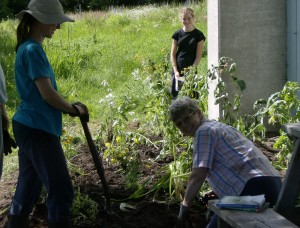 Provides wildlife habitat
Provides wildlife habitat
Local bird, butterfly and other wildlife have co-evolved with our native plants for thousands of years. By simply providing their local familiar favourites, your efforts will be rewarded with an incredible diversity of visitors to your garden.
Eliminate pesticides
As a result of having developed alongside their regionally occurring pests and diseases, native plants are naturally less susceptible to attack.
Reduce water usage
Having adapted themselves to a variety of local weather conditions, native plants are better equipped to withstand drought than many cultivated plant varieties.
Low maintenance
Since native plants require very little care once established, you will be able to just sit back, relax and enjoy your wonderful surroundings.
Save money
Native plants often propagate themselves quite freely, so you won’t have to replenish plant stock annually, as you would with bedding plants. You can also look forward to considerable savings from reduced pesticide and maintenance costs.
It’s naturally beautiful
From majestic oaks, fragrant vines and wetland irises to exotic woodland orchids and over 500 species in-between, Eastern Ontario is blessed with a rich tapestry of native flora to suit any personal preference or landscaping need.
WHAT TO LOOK FOR …
Complete Latin botanical names
This is the only way to correctly differentiate plant species, as many plants are known by the same common name. For example, if you want native High-bush Cranberry, insist on Viburnum trilobum, or you might come home with European High-bush Cranberry, Viburnum opulus. Also, steer clear of names varieties, which may include one or more names in quotation. So, while Chokecherry, Prunus virginiana, is native, Schubert Chokecherry, Prunus virginiana “Schubert’ is not.
Nursery propagated plants
Make sure the plants you purchase have been nursery propagated and NOT dug up from the wild. The last thing we want to do is support practices that disrupt or diminish populations in established plant communities.
Plants adapted to existing conditions
There are a number of native plants that will thrive in many conditions. Know which plants are naturally suited to your existing site, and select the right plant for the right site.
Provenance of plant stock
Select plants that have been grown in conditions similar to those in which they will be placed. This helps to avoid transplant shock, and ensures a better chance of survival.
Quality and health above size
Look for plants that are full, lush, healthy, and well branched, and possess strong, well-established root systems. Small perennials with several crowns in the pot will yield better results than a tall, singular plant.
GREEN GARDENING LINKS
Pesticide Free Ontario
Facts about pesticide use in Ontario. How pesticides are affecting you, and what you can do about it.
Pesticide Action Network
This database contains lots of information on pesticide toxicity.
The Dirt Doctor
American yes, but excellent.
Natural Care Lawn and Garden Products
Source of organic fertilizers in Gananoque (Eastern Ontario).
Evergreen Foundation
Database of Canadian native plants.
Evergreen Avenue in Smiths Falls
Native plants planted on REAL’s Evergreen Avenue memorial pathway in Smiths Falls.
Natural Insect Control
Environmental lawn and garden control products. A source for Beneficial Insects, books for the birdwatcher and some interesting environmentally themed novelties. Mail order.
Environmental Factor
Mail order source for organic fertilizers and corn gluten meal (weed suppressant).
National Coalition Against the Misuse of Pesticides (NCAMP) Lists alternatives, or safe pest management techniques.
Pesticide Action Network North America (PANNA). The also produce a database of individual pesticides and their effects.

